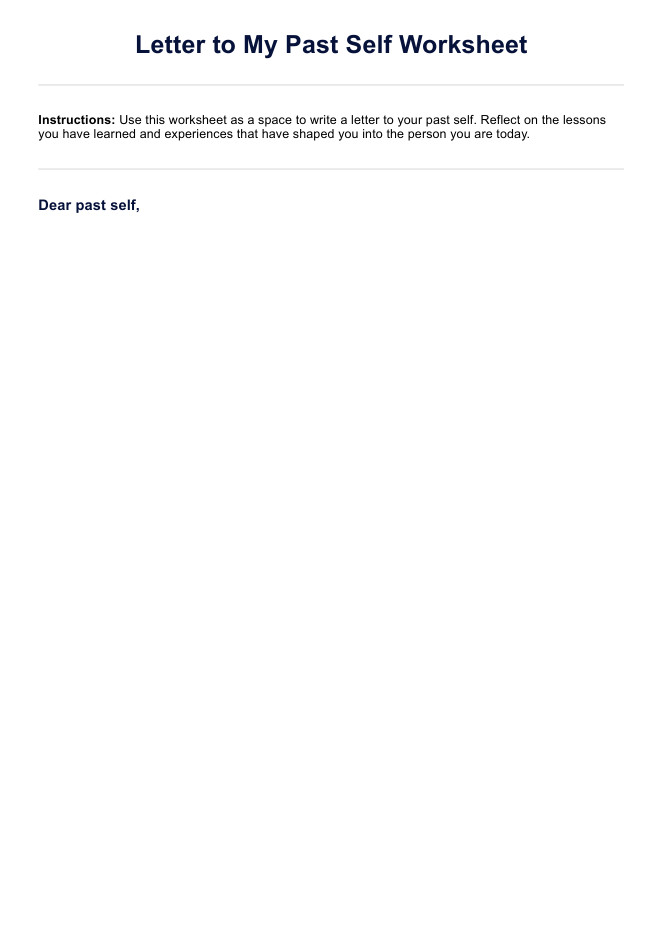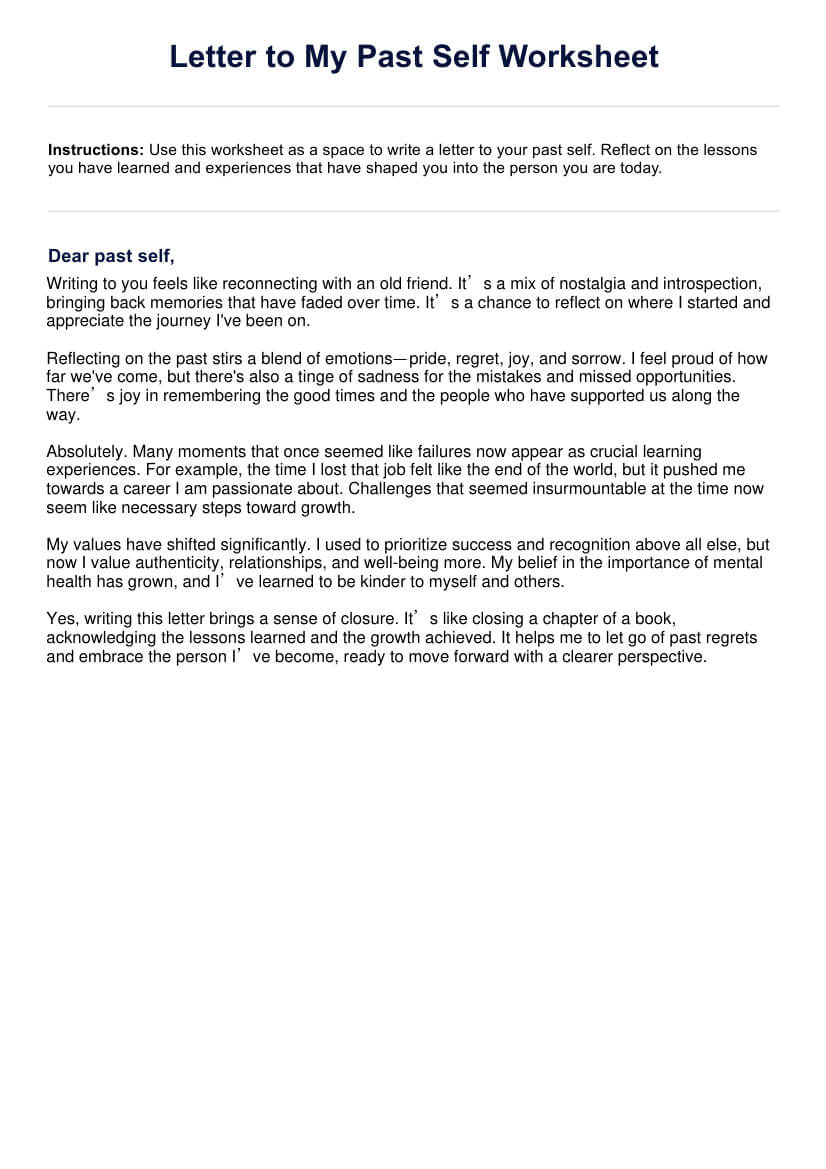Letter to My Past Self Worksheet
Discover how writing a letter to your past self can promote healing and self-awareness. Download our free worksheet and explore our therapy software, Carepatron.


Why is interacting with your past self a good therapy practice?
Writing a letter to your past self is a potent exercise in self-compassion and reflection. It allows individuals to confront past experiences with empathy, promoting healing and offering unique insights into their personal development. Such letters often help people process unresolved feelings and forgive themselves or others. This therapeutic practice can increase self-awareness, cultivate gratitude, and potentially change how one views one's life trajectory.
When is the right time to interact or confront one's past self?
The ideal time for someone to engage with their past through letter writing is during transition periods or when past issues seem to resurface and affect current well-being. It can be particularly beneficial when a person feels ready to face and articulate past challenges or when guided by a therapist to explore specific life events in a structured manner.
Letter to My Past Self Worksheet Template
Letter to My Past Self Worksheet Sample
What is a Letter to My Past Self Worksheet?
This worksheet is designed to guide individuals through writing a reflective and meaningful letter to their younger selves. It provides prompts and a structured layout to help explore significant events, feelings, and lessons from the past. The worksheet encourages writers to address their past with kindness and understanding, facilitating a dialogue many find liberating.
What to expect from this worksheet
When using the "Letter to My Past Self" worksheet, participants can expect:
- Deep engagement: The worksheet prompts deep reflection on past life events, guiding users to explore significant moments and their emotions.
- Narrative healing: Through the structured writing process, participants can tell their stories from a place of hindsight and compassion, a powerful form of narrative therapy.
- Insight generation: As participants write, they often uncover new understandings about their past decisions and the impacts of those decisions, leading to valuable insights that inform their present and future selves.
Goals of this worksheet
The specific goals targeted by this worksheet are designed to facilitate a therapeutic journey:
- Promote self-forgiveness: One primary objective is to help individuals forgive themselves for past mistakes and learn to accept those parts of their life stories with kindness rather than judgment.
- Encourage emotional expression: The worksheet serves as a tool to help users articulate feelings they might have suppressed or not fully addressed previously, aiding in emotional clarity and release.
- Foster personal growth: Individuals are encouraged to extract lessons and wisdom that can positively shape their ongoing personal development and behavioral patterns by engaging with their past selves.
These elements collectively aim to provide a therapeutic framework that supports emotional healing and personal insight, ensuring a comprehensive approach to engaging with one's past through reflective writing.
When is it best for therapists to issue this?
Therapists often introduce this worksheet after initial discussions about a client's readiness to reflect on their past. It is best used when a client has already displayed some capacity to manage and articulate complex emotions. The worksheet can be a powerful tool in therapy sessions focused on self-acceptance and overcoming personal obstacles.
How to use our Letter to My Past Self Worksheet template
Start by downloading our website's "Letter to My Past Self" worksheet template. This template is designed to help you structure your thoughts and feelings meaningfully.
Step 1: Give your client a copy
You can either print out a hard copy or send them an electronic version via email. It's important for your client to have their own copy so they can work on it at their own pace and keep it as a personal reminder.
Step 2: Set aside dedicated time to fill out the worksheet
Encourage your client to set aside dedicated time, whether it's 30 minutes or an hour, to sit down and fill out the worksheet. This will allow them to fully focus on reflecting on their past self and writing a meaningful letter.
Step 3: Encourage honest and vulnerable writing
Remind your client that this letter is meant to be personal and for their eyes only. Encourage them to write in a raw, honest, and vulnerable manner. Tell them they can start with the phrase "dear past self" to make it more personal and intimate. This will help them truly reflect on their past self and the lessons they have learned.
Step 4: Discuss the letter with your client
Once your client has completed the letter, schedule a follow-up session to discuss it with them. This can be a powerful exercise in self-discovery and personal growth.
Step 5: Encourage your client to keep their letter as a reminder
Remind your client that this letter can serve as a reminder of their journey and how far they have come. Encourage them to keep it somewhere safe where they can revisit it whenever they need a reminder or motivation.This worksheet is more than just a letter; it’s a journey into your past that promotes healing and understanding. It gives you a powerful tool to reconcile with your younger self and potentially reshape your future self.
Benefits of using this worksheet
The "Letter to My Past Self" worksheet is a valuable tool for both individuals and therapists, offering significant therapeutic advantages:
- Structured self-reflection: This worksheet provides a well-organized framework for reflecting on one's past. Structuring the reflection process helps users methodically explore various unresolved aspects of their lives, ensuring no significant experiences are overlooked.
- Promotion of emotional expression and self-compassion: Writing to one’s past self encourages a deep and often cathartic expression of emotions. This process facilitates the expression of feelings—such as regret, sorrow, and joy—and fosters a compassionate perspective towards oneself. It's particularly powerful for offering forgiveness to oneself for past actions or the impact of others' opinions that have shaped one's self-view.
- Catalyst for personal growth: Engaging with past experiences through this worksheet can catalyze profound discussions on personal development and future aspirations. It prompts individuals to think about how they've grown and what they can learn from their past to inform their future decisions. This can be particularly enlightening when setting new personal goals or re-evaluating existing ones.
- Resolution of past conflicts: This worksheet can help bring closure to previously unresolved issues by addressing and articulating feelings about past events that still impact one's emotional well-being. This is crucial for moving forward without the burden of past emotions clouding one’s judgment or self-esteem.
- Enhanced therapeutic engagement: This worksheet can be a valuable tool for therapists to deepen the therapeutic relationship. It encourages clients to engage in therapy more actively and opens up new avenues for discussion that might not surface in traditional talk therapy settings.
Utilizing the "Letter to My Past Self" worksheet can significantly enhance personal insight and emotional health, making it a powerful addition to therapeutic practices focused on healing and growth.
Commonly asked questions
Writing to your past self can illuminate how past experiences and perceptions have shaped your current identity and actions. It promotes a deeper understanding of your personal history and emotional resilience.
Yes, you can revisit different stages of your past as often as needed. Each letter can offer new insights and deeper understanding, especially as you encounter new life experiences and challenges.
While beneficial for many, this exercise might not be suitable for individuals with unresolved trauma or those who may find revisiting the past too distressing without professional support. Always consider personal readiness and possibly consult a therapist.

.jpg)



















-template.jpg)


















































































